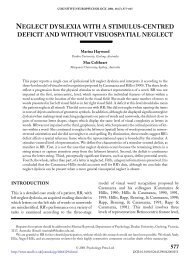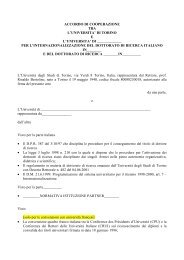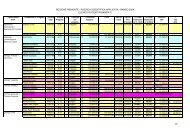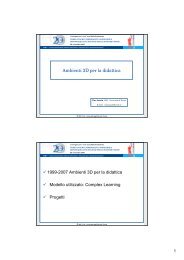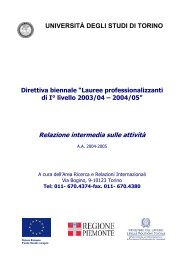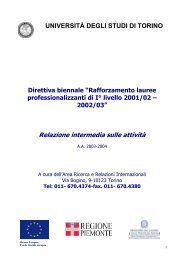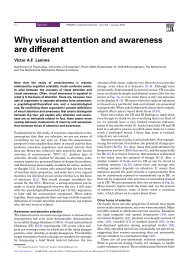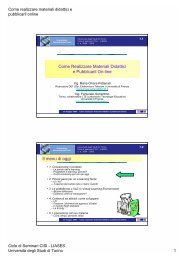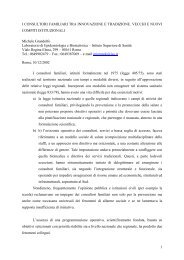Spatial hemineglect in humans - Cisi
Spatial hemineglect in humans - Cisi
Spatial hemineglect in humans - Cisi
You also want an ePaper? Increase the reach of your titles
YUMPU automatically turns print PDFs into web optimized ePapers that Google loves.
G. Kerkho€ / Progress <strong>in</strong> Neurobiology 63 (2001) 1±27 19<br />
Dieterich et al., 1998) thus modulat<strong>in</strong>g neural activity<br />
<strong>in</strong> a way that reduces neglect (see Section 14).<br />
13.6. One model or a synthesis of models?<br />
Given the multiple and dissociable phenomena of<br />
spatial neglect and the characteristically large lesions<br />
<strong>in</strong> neglect patients, it seems unlikely that any one<br />
model can expla<strong>in</strong> all features of neglect. Rather, every<br />
model is able to expla<strong>in</strong> some features but not other,<br />
and vice versa. Furthermore, some theories are compatible<br />
with each other although this po<strong>in</strong>t is rarely<br />
admitted by their proponents. For <strong>in</strong>stance, the shift<br />
of the SSA and visual exploration towards the ipsilesional<br />
hemispace by about 15±208 <strong>in</strong> left neglect is<br />
equally well expla<strong>in</strong>ed by the transformational theory<br />
as well as the salience model. Likewise, the reactiontime<br />
data by Smania et al. (1998), with the pathological<br />
reaction-time decrease <strong>in</strong> the neglect patients<br />
around 15±208 ipsilesionally is consistent with both<br />
accounts. F<strong>in</strong>ally, it would be possible to test the hypothesis<br />
whether the de®cit <strong>in</strong> the disengagement of<br />
attention (Posner et al., 1984) is modulated by egocentric<br />
parameters, i.e. the position of the head, hand<br />
or trunk <strong>in</strong> space, thus comb<strong>in</strong><strong>in</strong>g attentional and<br />
transformational approaches. F<strong>in</strong>ally, many of the sensory<br />
stimulation experiments described below are compatible<br />
with the idea of a cerebral (<strong>in</strong>)balance between<br />
various neural relay stations of a network distributed<br />
with<strong>in</strong> and across both hemispheres.<br />
To conclude, mutual <strong>in</strong>¯uences between the theories<br />
and research paradigms <strong>in</strong> the study of neglect <strong>in</strong> particular,<br />
and space cod<strong>in</strong>g <strong>in</strong> general, might be more<br />
fruitful than strict demarcations between the various<br />
`claims'. F<strong>in</strong>ally, the recent animal work on neglect<br />
(Lomber and Payne, 1996; Payne et al., 1996) deserves<br />
more attention.<br />
14. Modulation of neglect, ext<strong>in</strong>ction and unawareness<br />
by sensory stimulation<br />
A variety of di€erent techniques (see Vallar et al.,<br />
1997, for a detailed review) has been used to <strong>in</strong>¯uence<br />
neglect behavior (Fig. 10). Caloric (ice±water) stimulation<br />
of the contralesional ear (usually the left) or<br />
warm water stimulation of the ipsilesional ear (the<br />
right <strong>in</strong> patients with left neglect) stimulates the horizontal<br />
ear canal of the vestibular system and leads to a<br />
tonic deviation of the eyes towards the contralesional<br />
hemispace thereby reduc<strong>in</strong>g sensory neglect for some<br />
10±15 m<strong>in</strong>. This procedure also improves neglect-related<br />
disturbances of the body scheme on the contralesional<br />
side of the body as well (Rode et al., 1998) and<br />
<strong>in</strong> some cases transiently relieves the patient from his/<br />
her anosognosia for the left hemiplegia (10±15 m<strong>in</strong>;<br />
Rode et al., 1992). An easier and more tolerable stimulation<br />
procedure is optok<strong>in</strong>etic or slow visual motion<br />
stimulation with large-®eld visual displays conta<strong>in</strong><strong>in</strong>g<br />
stimuli all mov<strong>in</strong>g to the left or right. Leftward motion<br />
(<strong>in</strong> case of left neglect) temporarily reduces the l<strong>in</strong>ebisection<br />
error (Pizzamiglio et al., 1990; Matt<strong>in</strong>gley et<br />
al., 1994b). Similarly slow motion stimulation towards<br />
the neglected hemispace reduces the ``size'' and<br />
``space'' distortions transiently (cf. Fig. 10B, Kerkho€,<br />
2000) and temporarily reduces tactile ext<strong>in</strong>ction (Nico,<br />
1999). However, negative e€ects have also been<br />
observed with this procedure <strong>in</strong> a l<strong>in</strong>e-extension task<br />
with leftward optok<strong>in</strong>etic stimulation (Bisiach et al.,<br />
1996). It is likely that fast optok<strong>in</strong>etic stimulation<br />
leads to constant changes <strong>in</strong> eye-position which may<br />
render the perceptual task more dicult for a patient.<br />
We have found that slow motion stimulation (velocity:<br />
7.58/s) is completely sucient to observe full normalization<br />
<strong>in</strong> perceptual neglect tasks (Kerkho€, 2000).<br />
This further <strong>in</strong>dicates that the motor component of the<br />
optok<strong>in</strong>etic nystagmus obta<strong>in</strong>ed with high-speed stimulation<br />
is not crucial for the modulatory e€ect on<br />
neglect (Matt<strong>in</strong>gley et al., 1994b).<br />
Another simple stimulation is `cue<strong>in</strong>g' the patient to<br />
attend to stimuli <strong>in</strong> the contralesional hemispace<br />
(Fig. 10C). Cue<strong>in</strong>g may simply be the verbal command<br />
to look further to the left or to require the patient to<br />
read a letter located on the left side of a l<strong>in</strong>e before he<br />
is allowed to attempt bisection (Riddoch and Humphreys,<br />
1983) or to display ¯icker<strong>in</strong>g stimuli <strong>in</strong> the<br />
contralesional hemispace (Butter et al., 1990). L<strong>in</strong> et<br />
al. (1996) have recently elaborated this cue<strong>in</strong>g paradigm.<br />
They showed that circl<strong>in</strong>g of a digit at the left<br />
end of a l<strong>in</strong>e and the trac<strong>in</strong>g of the complete l<strong>in</strong>e with<br />
the right <strong>in</strong>dex ®nger was the most e€ective cue<strong>in</strong>g<br />
procedure: it led to a complete normalization of the<br />
l<strong>in</strong>e bisection error <strong>in</strong> left neglect.<br />
Vibration of the contralesional neck muscles leads to<br />
a temporary shift of the SSA towards the contralesional<br />
hemispace (Karnath et al., 1993) and reduces<br />
neglect-related omissions of visual stimuli <strong>in</strong> this hemispace.<br />
A similar transient e€ect can be achieved<br />
through selective rotation of the head (Sch<strong>in</strong>dler and<br />
Kerkho€, 1997; Kerkho€ et al., 1999b) or trunk (Karnath<br />
et al., 1991; Sch<strong>in</strong>dler and Kerkho€, 1997; Sp<strong>in</strong>elli<br />
and Di Russo, 1996) towards the left hemispace<br />
while ®xation rema<strong>in</strong>s straight ahead (Fig. 10D, E).<br />
Similar e€ects have been reported with di€erent body<br />
positions (upright versus sup<strong>in</strong>e). The activity of the<br />
otoliths of the vestibular system is reduced <strong>in</strong> a sup<strong>in</strong>e<br />
body position. Position<strong>in</strong>g neglect patients <strong>in</strong> a sup<strong>in</strong>e<br />
position reduces neglect (i.e. <strong>in</strong> l<strong>in</strong>e bisection; Mennemeier<br />
et al., 1994; Pizzamiglio et al., 1997).<br />
Apart from passive arm position<strong>in</strong>g active movements<br />
of the contralesional, left arm <strong>in</strong> left hemispace<br />
further leads to a temporary reduction of sensory




